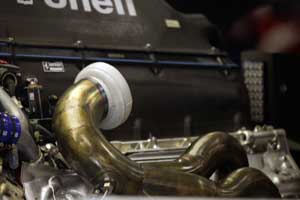OCTOBER 18, 2005
The V10 formula of 2006?

Some time ago the FIA asked Formula 1 teams to accept rules which rev-limited V10 engines. The federation argued that this would slow the cars and cut costs. As early as 1996 FIA President Max Mosley proposed an engine rev limiter to be introduced in 2001. The teams argued that Formula 1 is all about performance and pushing the limits. It seemed that Mosley had given up when last year he announced that there would be 2.4-litre V8 engines in 2006 to reduce power and costs. Mosley added that "in order not to prejudice the smaller independent teams" the existing 3-litre V10 engines would be allowed to continue in 2006 and 2007 "subject to a restriction on revs to be determined by the FIA". The teams were finally forced to accept this change, although several were strongly opposed to the V8 idea. And so, in theory at least, we will see a 2.4-litre V8 engine formula in 2006 and all the major F1 teams are working on the development of the new V8s. Only Squadra Toro Rosso (aka Minardi) is planning to go into the new season with a rev-limited V10. The stated FIA plan was that "the rev limit will be set at a level which will ensure that the engine is less powerful - but not much less powerful - than the 2.4s." In recent months, however, it has been clear that the V8s will not be very powerful and, more importantly, will have less robust rev ranges than the restricted V10s and there are some who believe that the rev-limited V10 engine could actually be a better package because with the two-race engine rule revs have been reduced anyway. There has been a lot of talk recently of changing the equivalency factor but if it remains the same we are likely to see teams begin to realise that the V8 is not the way to go and switch to rev-limited V10s instead. There is a precedent in all this as Honda decided in 1988 that rather than switch to new normally-aspirated 3.5-litre engines it would maximise the performance of the older turbos despite a boost pressure cut from 4 to 2.5 bar and a fuel tank capacity reduced from 195 to 150 litres. The result was a dominant car which won 15 of the 16 races. So be prepared, we may end up with a field full of rev-limited V10s next year. When you stop to think about it, this is what the FIA wanted all along and all that the manufacturers will end up with are expensive V8s which will be thrown on the scrap heap. Once teams have accepted rev limits, the FIA would then be able to control engine power quite simply by lowering the rev-limits from one year to the next, particularly if the V8 rules were later scrapped. And once the revs are low there would be little opposition to regulations demanding engines which last for six races.